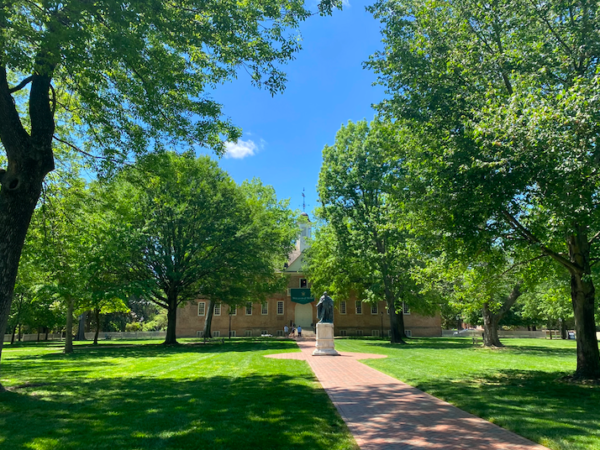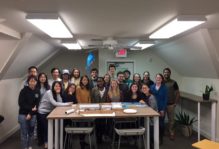Solar Accessibility for Low- to Moderate-Income Communities
By Emma Rebour ’21
The Environmental Science & Policy major at William & Mary is characterized by its intersectional nature. Throughout my time at William & Mary, I’ve taken courses ranging from the American Renaissance to chemistry to environmental ethics. This is truly what I love about being an Environmental Science major: we are one department composed of many. Starting college I knew I wanted to study the environment and our natural world, so during my early years, I focused on fulfilling the necessary requirements for the major. As I started my junior year, I began to understand how comprehensive this field of “environment” truly was, and so I began to think more specifically about where my passion lay.
As an intern at the Office of Sustainability, I’ve been able to work on a variety of projects. My work with the Climate Action Plan started with public higher education institutions in Virginia. I researched to what extent these universities had climate action plans or any renewable energy use. I’ve also worked with W&M’s greenhouse gas data, building graphs and charts to be used in the school’s short report. Working on these projects felt fun, and thus I started to think more deeply about energy and our carbon footprint at different scales. The summer after my junior year I started collaborating with Cydnie Golson, an intern at the University of Virginia, to figure out how to best engage the student bodies in our joint Climate Action Plan. This semester we organized a webinar to foster discussion about student engagement in the Climate Action Plan and outlined the school’s next steps to the student body. We asked questions like, “What would a transition to renewable energy look like for my school and country?” The diversity in projects I’ve been able to work on under the scope of sustainability is what has made my internship so valuable and unique.
 Centering sustainability throughout my education at William & Mary has made me realize two things. First, the next step to solving our global and national climate crisis is a transition to carbon neutrality and decreased fossil fuel consumption. Secondly, renewables have immense potential to change the way our unsustainable energy systems currently operate. I knew that I wanted to play a role in an equitable transition to renewables because of the vast potential sustainable energy sources have to redefine our energy grid. Following this realization, I worked with Calandra Waters Lake, the Director of Sustainability, to brainstorm ideas for my capstone research project. Ultimately, I decided to work with Solar United Neighbors, a nonprofit committed to the equitable distribution of solar energy. Thinking locally, Virginia is a state in which solar energy is rapidly growing, but only small and obscure provisions are allocated to low- and moderate-income communities. For these populations, many barriers stand in the way of achieving access to clean energy.
Centering sustainability throughout my education at William & Mary has made me realize two things. First, the next step to solving our global and national climate crisis is a transition to carbon neutrality and decreased fossil fuel consumption. Secondly, renewables have immense potential to change the way our unsustainable energy systems currently operate. I knew that I wanted to play a role in an equitable transition to renewables because of the vast potential sustainable energy sources have to redefine our energy grid. Following this realization, I worked with Calandra Waters Lake, the Director of Sustainability, to brainstorm ideas for my capstone research project. Ultimately, I decided to work with Solar United Neighbors, a nonprofit committed to the equitable distribution of solar energy. Thinking locally, Virginia is a state in which solar energy is rapidly growing, but only small and obscure provisions are allocated to low- and moderate-income communities. For these populations, many barriers stand in the way of achieving access to clean energy.
My capstone project has been dedicated to researching how solar energy can be made more accessible to low- and moderate-income populations. On average “low-income households pay 7.2% of their income on utilities — higher-income households only pay 2.3%” (ACEEE, 2016). Thus it’s clear an energy burden is disproportionately placed on low-income communities. I have spent many late nights reading low-income solar policy guides, interviewing professionals from different areas of the solar industry, and have analyzed the most successful programs doing this work in Virginia. From all of this research, I’ve learned industry-specific terminology, best practices, common challenges, and where the greatest avenues of potential lie. For many low- to moderate-income communities, such programs are their first exposure to solar energy. Having historically been victims of scams, false advertising, and racist government programs, their trust in government and outside organizations has decayed. This is why building community engagement, establishing trust, and effective communication are some of the key tenets of this work. Collaborating with schools, churches, and community centers allows for community building and the sharing of solar wealth. These programs are not always easy to run, but they have the potential to make significant and meaningful changes in people’s lives. After years of racist energy policies, as seen through redlining and strategic waste site placement, equity can no longer be an afterthought.
As my senior year comes to an end, so does my capstone research. Both of these transitions are bittersweet. Although the majority of my learning has been online, I am so thankful for the opportunities I’ve been given during my time at William & Mary. Many things remain uncertain, but one thing I do know is that renewable energy is integral to our country’s future, and steps to ensure a just and equitable transition are imperative. As I graduate, I’m excited at the possibility of working in the renewable energy sector and checking in with William & Mary as climate action efforts continue to grow on campus.



No comments.
Comments are currently closed. Comments are closed on all posts older than one year, and for those in our archive.